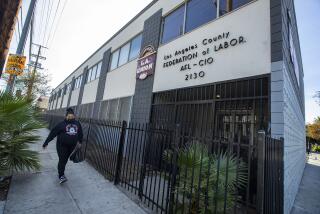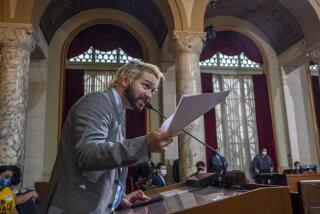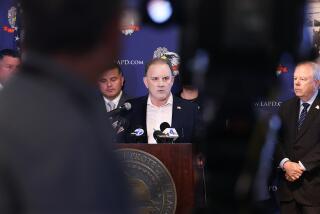Latest Twist in Beating Roils Waters
Critics and supporters of the Los Angeles Police Department said Wednesday they were troubled by a report in The Times that a suspected car thief was not carrying wire cutters in his pocket when arrested, contradicting the department’s preliminary account of the televised beating.
A source told The Times that Officer Peter Bueno planned to inform LAPD investigators he found the wire cutters about 200 yards away -- in the car allegedly stolen June 23 by suspect Stanley Miller.
The discrepancy is significant because the presence of wire cutters in Miller’s pocket would seem to support officers’ claims that they believed he was armed. Officer John J. Hatfield struck Miller 11 times with a flashlight after the suspect appeared to surrender.
John Mack, president of the Los Angeles Urban League, said the Times story “knocks a hole” in the officers’ reported version of the arrest and “brings back bad memories” of past LAPD abuses.
“This incident just suggests to me that some of these officers have not learned anything from the [Rodney G.] King beating and the Rampart” corruption scandal, said Mack, who heads a civilian monitoring panel appointed by Mayor James K. Hahn to look into the latest beating. “Some of them still apparently believe [that] because they have a badge and a gun and are in the process of going after the ‘bad guys,’ they can cross that line and themselves engage in behavior that is just as bad.”
Mack and others said Wednesday that such a major discrepancy in the police report would raise questions about the extent of LAPD reforms since the 1991 beating of King. Lying on a police report can be a felony.
At the same time, a number of people charged with overseeing the department’s investigation into the Miller case said the incident might mark a turning point -- breaking LAPD officers’ tradition of protecting colleagues no matter the truth.
David Cunningham III, president of the five-member civilian Police Commission, said that if officers came forward to tell of inaccuracies, it would indicate “that the code of silence is being supplanted with the code of honor.”
“If that is the case,” Cunningham said, “it’s very good news. It’s saying this is not the time to be silent if there is misconduct.”
Police Chief William J. Bratton, through a spokeswoman, declined to answer any questions Wednesday.
“The chief has said from Day 1 that this investigation is going to be a transparent investigation,” Mary Grady said. “But it is still a personnel investigation, and the bottom line is: We are looking for the truth.”
Hahn declined to comment Wednesday on the investigation.
“I don’t want to be in a position of every day trying to confirm or deny what the latest leak is,” he said.
In addition to the question of where officers found the wire cutters, a source close to the investigation said Wednesday that four of the officers on the scene said they “didn’t hear, didn’t see, didn’t feel anything resembling a gun.”
Their statements would conflict with those made by the first three officers to reach Miller -- including Hatfield -- and muddy reports that the arresting officers beat Miller because they believed he was armed. It was unclear, however, how many of the officers would have been close enough to hear Officer David Hale shout a warning.
Hale allegedly told police investigators that he yelled, “Gun!” after feeling what he believed to be a weapon in Miller’s pocket. Such a warning could justify the force used to subdue the suspect, according to department rules.
Miller had led police on a half-hour car chase in a stolen Toyota Camry before jumping out and sprinting alongside a concrete creek bed in Compton. Eight officers were at the scene of the arrest shortly before 6 a.m. One police and two TV news helicopter crews hovered overhead as officers ran after Miller.
Hale and Officer Phillip Watson tackled the suspect. Seconds later, Hatfield kicked at Miller, who was lying on the ground, and then struck him 11 times with a flashlight. Hatfield also was shown delivering at least five blows to Miller’s upper body. Hale, Watson and Hatfield all said “Gun” was shouted, according to a source familiar with their accounts.
Under federal oversight as a result of the Rampart Division scandal, the LAPD is required to immediately separate officers involved in lethal uses of force in order to eliminate the opportunity for them to agree on a version of events.
Critics have questioned why it took the LAPD 40 minutes to separate the officers in the Miller case and whether the officers used that time to discuss what they should say about the arrest.
Assistant Chief George Gascon told the City Council that Miller was carrying the wire cutters, and a picture was projected onto a screen at a council meeting two weeks ago during a preliminary briefing.
Police Commissioner Corina Alarcon said, “If information was given at a City Council hearing and it turns out to be different, I would expect a lot of clarification.”
Councilman Bernard C. Parks, who preceded Bratton as chief and has sharply criticized the department, said Wednesday that it was “very serious” if a police officer filed a false report. Parks said he hoped that Bratton would come back before the City Council to clarify what happened during the arrest.
But in a sign of support for the current chief, who replaced Parks 21 months ago, many community leaders said Wednesday that they would withhold judgment until the LAPD completed its investigation.
“Is it a problem? Yes. Is it bad policing? Yes,” said Rabbi Abraham Cooper, a member of Hahn’s monitoring panel. “It’s not racism, as I see it. This is further proof that Bill Bratton and his team are committed to making the necessary changes to make every Angeleno proud of the LAPD. It’s not going to happen overnight.”
Khalid Shah of Stop the Violence Increase the Peace said he believed it was too soon to judge the police investigation or the arrest.
“Of course it may look bad, and it may be bad,” said Shah, who is working on an alternative citizen panel organized by L.A. Sentinel newspaper owner Danny Bakewell. “We do the process a disservice by rendering any kind of judgment until we can find out what the facts are.”
Mack said he spoke to Bratton on Wednesday about the Times story and was assured that the LAPD remained committed “to following the truth wherever it leads them.”
Mack said that when he first heard the initial version of the arrest, including the discovery of the wire cutters in Miller’s pocket, he thought it “smelled fishy.”
“The majority of people, particularly in the African American community, remember there is a long-standing history of conflicts and cover-ups by the LAPD,” he said.
On the one hand, Mack said, he found it “very disturbing” that the police report might be wrong. But he said it would be a hopeful sign if an officer was willing to correct the record.
“If indeed one officer is prepared to step up and tell the truth,” he said, “it’s a step in the right direction.”
*
Times staff writer Noam Levey contributed to this report.
More to Read
Sign up for Essential California
The most important California stories and recommendations in your inbox every morning.
You may occasionally receive promotional content from the Los Angeles Times.












